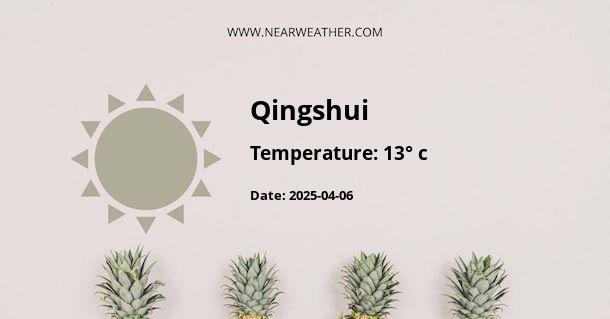Climate and Weather in Qingshui, China
Qingshui, located in China, experiences a diverse and unique climate throughout the year. The region's climate can be classified as a humid subtropical climate, influenced by its proximity to the Pacific Ocean and the surrounding topography. This article will provide a comprehensive overview of Qingshui's climate and weather patterns, including temperature variations, precipitation levels, and seasonal changes.
Temperature
The temperature in Qingshui varies significantly throughout the year, with distinct seasons and noticeable temperature differences between day and night. Summers in Qingshui are hot and humid, with average high temperatures ranging from 30°C (86°F) to 35°C (95°F). The hottest months are typically July and August, when temperatures can occasionally reach above 40°C (104°F). Winters, on the other hand, are relatively cool, with average low temperatures ranging from 5°C (41°F) to 10°C (50°F). The coldest months are usually January and February.
Spring and autumn in Qingshui are transition seasons characterized by mild temperatures. Spring, from March to May, sees a gradual increase in temperatures, with average highs ranging from 15°C (59°F) to 25°C (77°F). Autumn, from September to November, experiences a similar temperature range, with average highs between 20°C (68°F) and 30°C (86°F). These seasons are generally considered pleasant, with comfortable weather for outdoor activities.
Precipitation
Qingshui receives a moderate amount of precipitation throughout the year, influenced by the East Asian monsoon and its geographical location. The wettest months are typically June and July, during the peak of the summer monsoon season, with average rainfall exceeding 200mm (7.9 inches) per month. The monsoon brings heavy rainfall and occasional thunderstorms to the region.
Winter, on the other hand, is the driest season in Qingshui, with significantly reduced precipitation. Average monthly rainfall during winter months, such as December and January, drops to around 20mm (0.8 inches). Spring and autumn experience moderate rainfall levels, with average monthly precipitation ranging from 50mm (2 inches) to 100mm (3.9 inches).
Seasonal Changes
Qingshui experiences distinct seasonal changes, with each season offering its own unique characteristics and weather patterns. Spring, as mentioned earlier, brings a gradual increase in temperatures and the blooming of cherry blossoms and other flowers. It is a popular time for outdoor activities, such as hiking and sightseeing.
Summer in Qingshui is characterized by hot and humid weather, with occasional rain showers and thunderstorms. The high temperatures make it an ideal season for beachgoers who enjoy swimming and water sports. Autumn brings cooler temperatures and colorful foliage, creating picturesque landscapes. It is an excellent time for hiking and exploring the natural beauty of the region.
Winter in Qingshui is relatively mild compared to other parts of China, but it can still be chilly, especially during the evenings. While snowfall is rare, the surrounding mountains may experience light dustings of snow, adding a touch of winter charm to the area.
Conclusion
Qingshui, China, experiences a humid subtropical climate with distinct seasons and variations in temperature and precipitation throughout the year. Summers are hot and humid, winters are cool, and spring and autumn offer mild temperatures. The region receives moderate rainfall, with the wettest months being June and July. Qingshui's diverse climate and unique seasonal changes make it an attractive destination for outdoor enthusiasts and nature lovers.
A - Qingshui's Latitude is 31.317240 & Longitude is 118.476860.
A - Weather in Qingshui is 13° today.
A - Climate Conditions in Qingshui shows clear sky today.
A - Humidity in Qingshui is 58% today.
A - Wind speed in Qingshui is 5.15 km/h, flowing at 136° wind direction. today.
